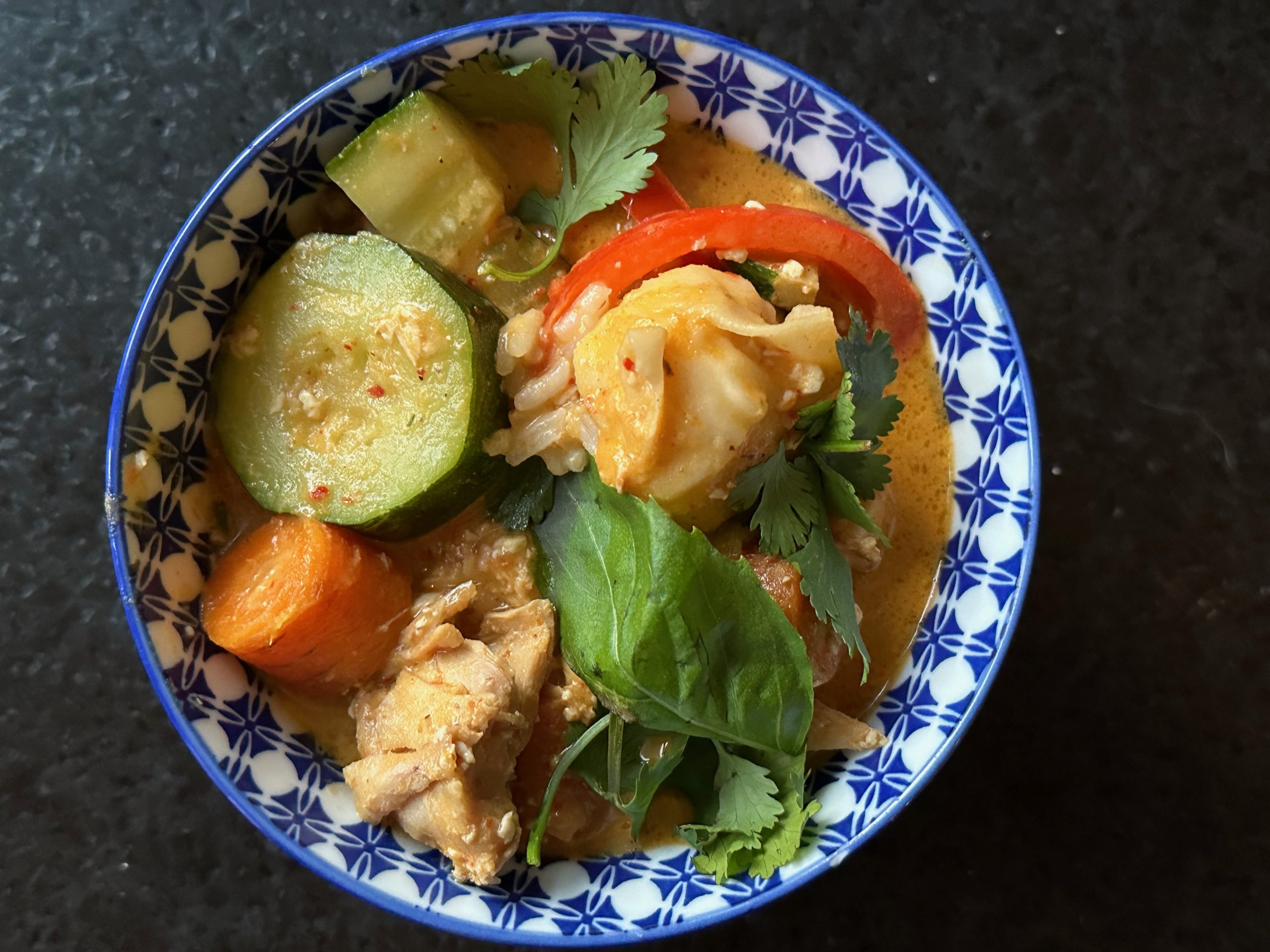He didn’t like curry, and to this day purports to hate coconut, but my son Remy would walk on molten lava for a bowl of red chicken curry. I don’t need to solve this paradox to benefit from the fact that curry offers great leverage to get kids and grownups alike to eat their vegetables. A good curry allows you to work with whatever is fresh, and there are almost as many curry recipes around the world as there are vegetables at the farmers market. I like Thai curry because it is the easiest to make and most delicious to taste.
Green curry is more pungent and bitter, and often the most challenging of the Thai curries. Yellow is sweeter and mellower but no less complex, and reminiscent of Indian curry thanks to the turmeric. Red curry has lots of red chile and coriander and shrimp paste. Remy has no interest in green or yellow. It seems that some ingredient or combination of ingredients specific to red curry must cancel the element of coconut that so offends him.
It shows the power of a Thai coconut curry, the flavor of which is built on the interaction between two powerful and opposing forces. On one side, concentrations of spices that would be too intense to handle were they not neutralized by the other side, the equally off-the-charts opposing force of rich, creamy, fatty coconut.
Thanks to the availability of spice paste and canned coconut, we can plug in our local veggies and proteins and make homemade curry on the level of what you might eat in Bangkok, an extraordinarily high bar. You could argue it’s more “authentic” to grate and squeeze out the coconut milk, or to grind your own spices, but in Thailand it’s totally normal to use canned coconut, unless it’s for a special occasion, or if you’re living on the beach. And they purchase their curry paste at the market from their preferred curry paste vendor.
The curry paste you can find stateside at your local Asian supermarket is just as authentic, if more mass-produced. While you’re at the Asian store, get a sack of high-end jasmine rice, some boxes of unrefrigerated silken tofu for use as a thickener, and a bag of shrimp shumai dumplings — I dump dumplings in my curry for extra fun.
Although there are three colors of Thai curry, and countless veggies and proteins available to incorporate, you only need one recipe. Here it is, in the form of chicken red curry, with seasonal veggies like potatoes, carrots and onions from last year’s harvest, and some fresh herbs and greens of spring, supplemented with Mexican zucchini and bell pepper from my local supermarket.
A Red Curry
As with a stir-fry, you should add the vegetables in order of how long they take to cook. Tomatoes, potatoes and winter squash can go in early, while broccoli, zucchini, dumplings go later.
Serves 4
2 chicken breasts or the equivalent amount of chicken, cut into inch-cubes
1 box of firm silken tofu, cut into inch-cubes
2 tablespoons cooking oil
2 cups jasmine rice
1 medium onion, minced
1 can full fat coconut milk
2 medium potatoes, chopped into ¾-inch chunks
2-4 tablespoons Thai red curry paste
2 tablespoons sugar
1 large carrot, cut into ½-inch rounds
1 medium-sized zucchini, cut into ½-inch rounds
(other vegetables, as available.)
Optional: a package of shumai dumplings
1 red bell pepper, sliced
1-2 tablespoons fish sauce
Fresh basil, cilantro or other herbs
Add the fry the chicken pieces, skin down, and tofu in the oil on medium heat. You don’t need to stir it. If they all have a single browned side it’s fine.
While that is happening, add the rice to another pot and fill it with water, stirring the rice with your hand to get the starch off, which will make the water cloudy. Change the water and repeat, as often as it takes until the water comes out clear. Then add 2 cups of water, so that the rice is covered by about ¾-inch. With a tight-fitting lid, cook on high until it boils, then turn down to medium for about ten minutes, until the water is gone and the rice is puffy.
When the chicken and tofu are starting to brown, add the onions. After about ten minutes, add a cup of water to loosen the fond, and give the whole pan a stir. Add the coconut milk and potatoes.
Bring to a boil. Simmer for five minutes. Add the curry paste, sugar and carrots. Simmer for 30 minutes, adding water as necessary to keep it thin and soupy.
Add the zucchini, dumplings, bell pepper and fish sauce. Simmer for ten more minutes. Taste. Adjust seasonings with fish sauce, soy sauce or salt, and serve, garnished with fresh herbs.
